Laptop Mag Verdict
Epic battery life, a gorgeous screen, sharp camera and powerful software make the Galaxy Note 3 the most versatile smartphone on the market.
Pros
- +
Epic battery life
- +
Gorgeous screen
- +
Powerful pen software
- +
Strong performance
- +
Improved multitasking
Cons
- -
Audio could be better
- -
Design not one-hand friendly
- -
Relatively expensive
Why you can trust Laptop Mag
Samsung popularized the phablet (a smartphone-tablet hybrid) with 2011's Galaxy Note and kicked it up a notch last year with the Galaxy Note 2. However, the Galaxy Note 3 takes the world's best pen-enabled smartphone to a whole new level with a gorgeous 5.7-inch, full-HD screen, a host of new pen enhancements, improved multitasking and a thinner, lighter design. Throw in more than 11 hours of battery life -- among the best we've ever seen -- and you have the most powerful and functional Android smartphone on the market. But is this big-screen beast right for you?
[sc:video id="locnE1cTrUtysZxI5LMdXvGTRrYTnPCX" width="575" height="398"]
Design
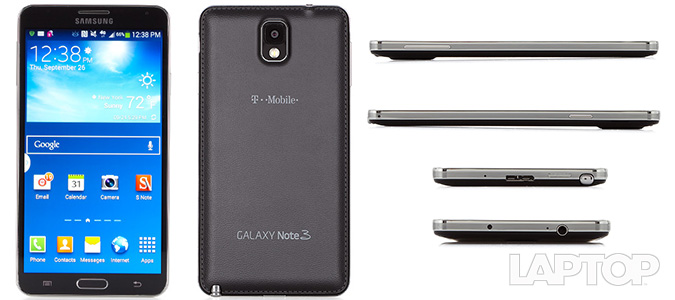
At 5.95 x 3.12 x 0.33 inches and 5.9 ounces, the Galaxy Note 3 is noticeably thinner, lighter and narrower than the Galaxy Note 2 (5.9 x 3.2 x .37 inches, 6.3 ounces), despite having a screen 0.2 inches larger than its predecessor's 5.5-inch panel. Even though the Note 3 is much larger than leading non-phablets, such as the Samsung Galaxy S4 (5.31 x 2.69 x 0.25 inches, 4.6 ounces) and the HTC One (4.87 x 2.31 x 0.30 inches, 3.95 ounces), this new Galaxy was more than light enough to carry in one hand and thin enough to fit in our front pants pocket.
However, we did have to get used to using a wider grip than on smaller handsets. For instance, it's nearly impossible to stretch your thumb across the display to touch the phone icon on the home screen. For the most part, this is a two-handed device.
Though Samsung's plastic phone still can't match the luxurious aluminum designs employed by HTC and Apple, the Galaxy Note 3 looks quite a bit classier than its predecessor. The new Note sports ridged metallic-colored sides, a slim bezel and a faux-leather back that's designed to make the phone look more like an old-fashioned paper notebook. The soft feel of the back plastic was more pleasant to grip than the glossy plastic used on other Samsung phones, but we'd prefer a material that's not pretending to be something else.
Like other Samsung Galaxy phones, the Note 3 has a hardware home button to go along with the capacitive menu and back buttons below its screen. Conveniently, the back pops off to give you access to the removable 3,200-mAH battery and a microSD card slot that supports cards up to 64GB in capacity.
MORE: Hyperion Extended Battery Nearly Doubles Battery Life of Galaxy Note 3
The Galaxy Note 3 is the first smartphone we've seen that uses a microUSB 3.0 port for charging rather than a traditional microUSB 2.0. This higher-speed port allows for faster transfers and potentially faster charging times when you connect to a PC that has USB 3.0. Fortunately, we found that a regular microUSB connector also worked, filling half the port and allowing us to both charge and transfer files from an old-fashioned USB 2.0 port.
Display
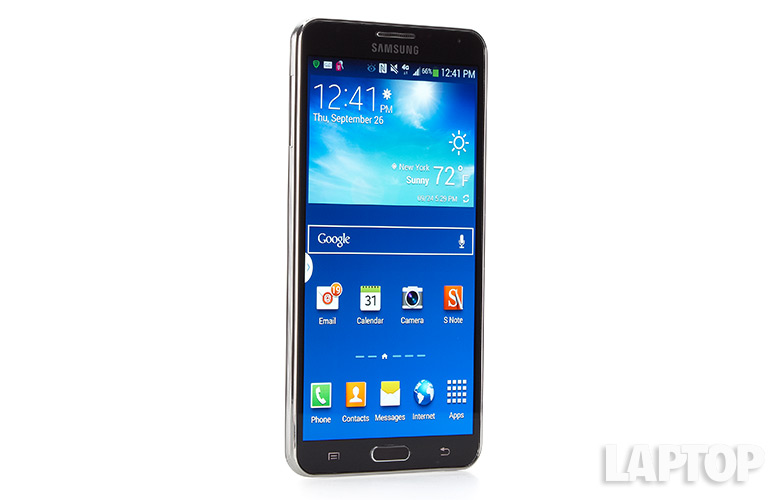
Click to EnlargeThe Galaxy Note 3's 5.7-inch, 1920 x 1080 display is one of the brightest and most vibrant we've seen, easily eclipsing other leading Android phones and arguably besting the iPhone 5s' display quality. At 539 lux on our light meter, the AMOLED panel is easily ahead of 396-lux category average, the 460-lux Galaxy S4, the 439-lux HTC One and the 500-lux iPhone 5s.
With that comparatively high level of brightness, it was easy for us to see the screen even in direct sunlight. When we played a 1080p trailer for "The Avengers" on the Galaxy Note 3, images were bright and sharp from all viewing angles, even 90 degrees to the left or right. When we compared the phablet's output to the same clip on the Galaxy S4, the image was markedly brighter and more colorful.
The 4.7-inch HTC One provided a slightly sharper image due to its higher pixel density (468.7 PPI vs. 386.5 PPI), but colors were much more vibrant on the Note 3's 5.7-inch display, with shades like the blue in Captain America's suit and the orange in an explosion appearing much more enticing and alive.
We also compared Samsung's phablet to Apple's 4-inch, 1136 x 640 iPhone 5s. While some shades, like blues and reds, looked more true-to-life on the iPhone, the Note 3 had better yellows and offered significantly more detail. Small items like the wounds on Thor's forehead were almost impossible to make out on the iPhone's display but seemed prominent on the Note 3.
MORE: Samsung 2013 Rating: Best and Worst Smartphone Brands
Audio
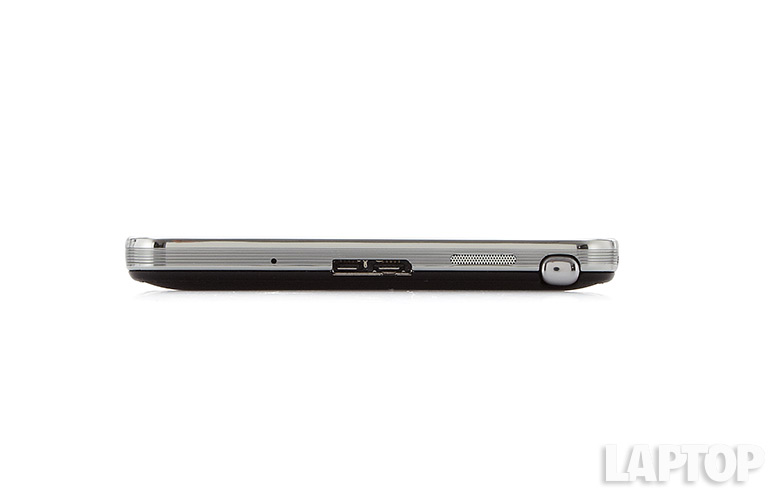
Click to EnlargeDon't even think about using the Galaxy Note 3 as a mini boombox. The bottom-mounted speaker delivered distorted music that was only loud enough to fill a small conference room and became almost inaudible when we leaned the phone against our chest or held a finger across the bottom. When we listened to the R&B classic "Forget Me Nots," Patrice Rushen's vocals sounded distant, as they were smothered by the bass. The Beastie Boys' guitar-heavy "Fight for Your Right to Party" became a fetid stew of tinny drums and muffled vocals.
Operating System and UI
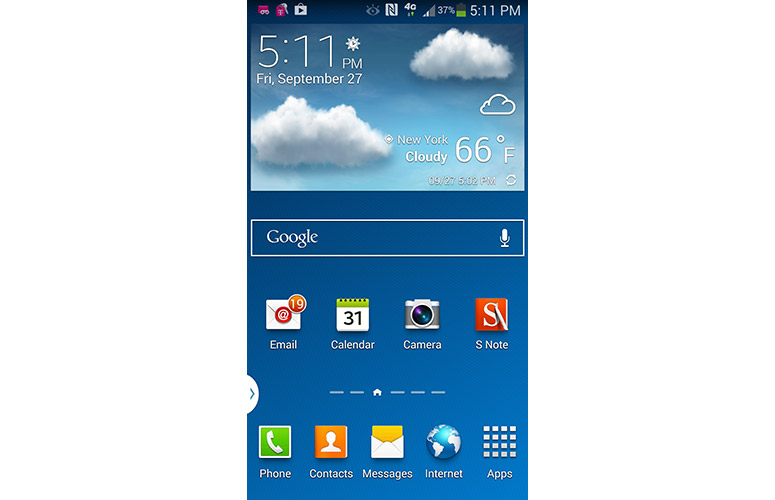
Click to EnlargeThe Galaxy Note 3 comes with Google's latest Android 4.3 operating system, covered over by the newest version of Samsung's TouchWiz skin. As with other TouchWiz phones, the Note 3 has icons on its six home screens and app drawer that look like they are floating on top of the blue-sky wallpaper and gradient-blue background.
If you're bored of looking at a traditional Android desktop with icons and widgets, swipe up and you can see a new home screen feature called My Magazine.
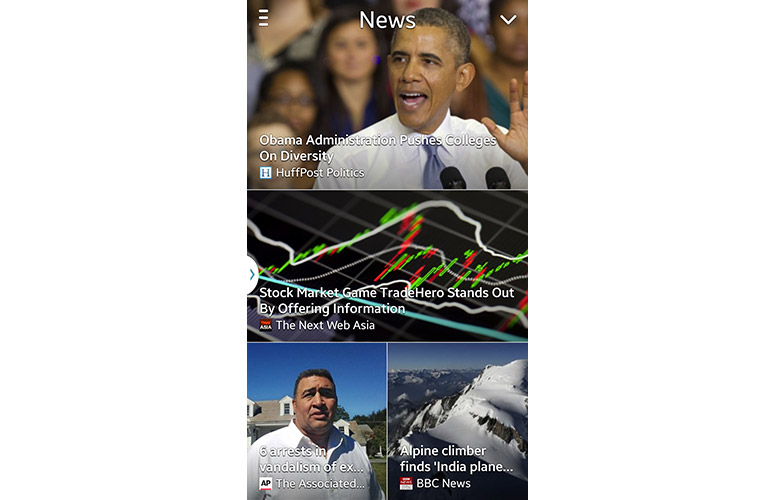
Click to EnlargeThis shows a photo-heavy customized newsfeed along with social updates and images of your recent notes. The software is based on Flipboard and looks and feels a lot like both the popular app and HTC's Blinkfeed home screen. If you enjoy news feeds with lots of big pictures, My Magazine is definitely worth a look.
Unlike the Galaxy S4, which had several pages of pre-loaded apps in its app drawer, the T-Mobile version of the Note 3 we reviewed fit all of its shortcuts onto one screen by placing several of them into folders. Executives at Google will probably throw a fit when they see that most of the major Google apps -- Gmail, Chrome, Google+, Hangouts, Play Movies and Play Music -- are buried in one of these folders, with only the Play store, YouTube and Google Maps receiving top-level slots. Samsung's own Web browser sits at the bottom of the main home screen and the top level of the app drawer.
MORE: 12 Worst Android Annoyances and How to Fix Them
Like the Galaxy S4 and other recent Samsung phones, the Note 3 has a Quick Settings menu that appears in the notification drawer when you pull down; it lets you toggle 20 different options, including Wi-Fi, NFC, gesture control and Multi-Window support. This menu also has a lock screen where you can place up to five quick shortcuts or do a quick swipe to get to additional apps or the camera.
Multi Window
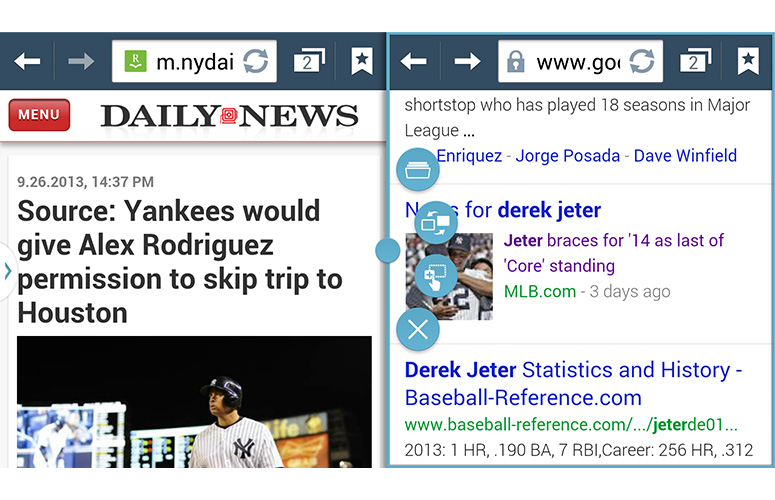
Click to EnlargeMulti Window mode is one of our favorite proprietary Samsung features, because it provides the desktop-like experience of placing two apps side by side. With the Note 3, Samsung has added the ability to place two windows from the same app next to each other, which was particularly useful when we wanted to look at two Web pages at the same time. A new context menu that appears as a blue dot between the two windows allows you to enable drag and drop. This allowed us to grab an image out of the gallery on the left side of our screen and drag it into the email client, where it became an attachment in a message we were editing. (We wish we didn't have to press a button first, but this function still works as advertised.)
Using the new Pen Window function, which allows you to open one of a few, select apps in a floating window, we were able to place a third window on top of the split screen. Among the eight apps that support this feature are Calculator, Clock, Youtube and Internet.
Keyboard
Samsung's virtual keyboard is among the most comfortable you'll find on any Android phone, and it works even better on the Note 3's 5.7-inch screen. Widely spaced keys made it easy for us to avoid hitting adjacent letters by accident; the dedicated number row saved us many mode switches, and the optional haptic feedback made it feel more like we were pressing hardware keys.
Based on the popular SwiftKey third-party keyboard, but with a unique design and layout, the Samsung keyboard learns from your typing habits and offers really strong next-word predictions. It also provides trace typing for those who like to form words by drawing between letters. A highly accurate handwriting mode let us draw words with the stylus and watch as they turned into on-screen ASCII text.
MORE: 5 Best Keyboard Apps for Android
Pen Experience and Apps
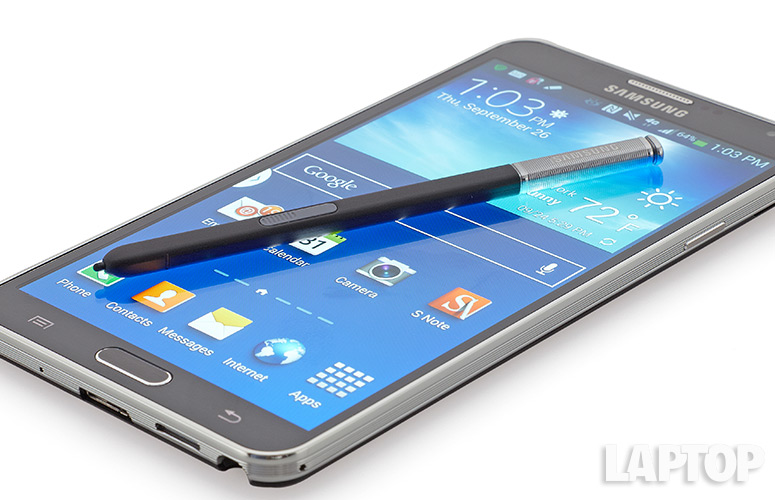
Click to EnlargeIt wouldn't be a Galaxy Note without its stylus and host of powerful pen-friendly apps. The Note 3's stylus feels just a tiny bit lighter than the last Note's pen, and the new version fit nicely between our index and middle fingers when we used the tool to write, draw or tap on-screen buttons. Because of the pen's flexible tip, pressing it against the glass screen felt a lot like pushing a ballpoint pen against paper.
Removing the stylus from its bay or clicking its single button while hovering above the display brings up Samsung's new Air Command menu, which offers five different pen-friendly utilities: Action Memo, Scrapbooker, Screen Write, S Finder and Pen Window.
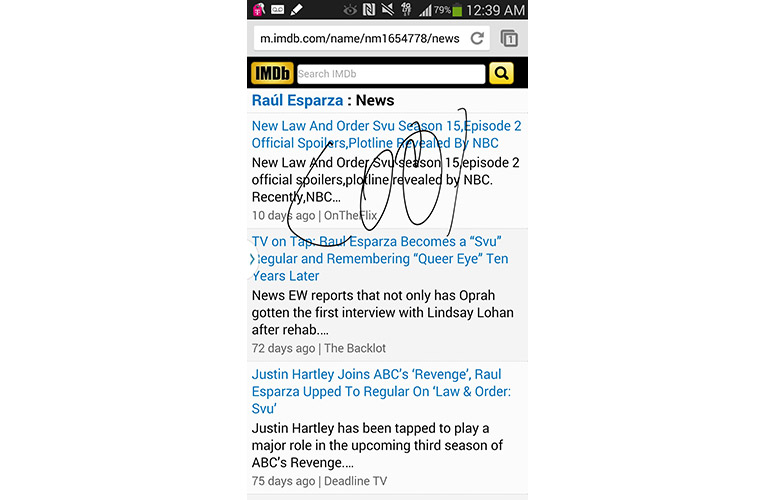
Click to EnlargeAction Memo creates virtual post-it notes that can be stored or minimized so they stay pinned on your screen wherever you go. When you draw a lasso or a circle around the text in an action memo, the application interprets your handwriting and gives you the option of dialing what you've written (if it's a phone number), mapping it (if it's an address), adding it to contacts, emailing it, sending it as an SMS message or adding it to your task menu.
Though the handwriting recognition in Action Memo was generally good, it didn't always provide enough accuracy for us to perform one of these actions based on our messy scribbles. When we wrote "Buy Milk" and tried to turn those words into a task, the app turned them into two tasks, "buy" and "milk." However, when we carefully wrote a phone number in better handwriting, the app converted all the numbers correctly and allowed us to add the number to our contact list.
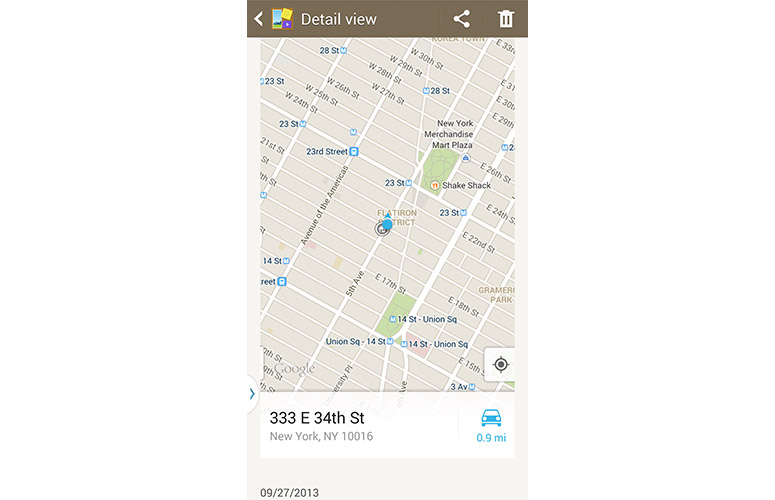
Click to EnlargeScrapbooker allows you to draw a box around any content you see on the screen and save it to a scrapbook, along with any associated metadata, a custom memo, and tags to help you find it later. When we drew a box around a picture of a home on a Web page listing real estate, Scrapbooker stored not only the photo but also the URL of the page so we could visit it again later. When we drew a box around an area of a Google map, Scrapbooker stored an image of the surrounding streets and the address, but not a link back to the maps app.
MORE: Best Apps 2013
Screen Write simply takes a shot of the entire screen and then allows you to scribble on top of this shot and save or share the result.
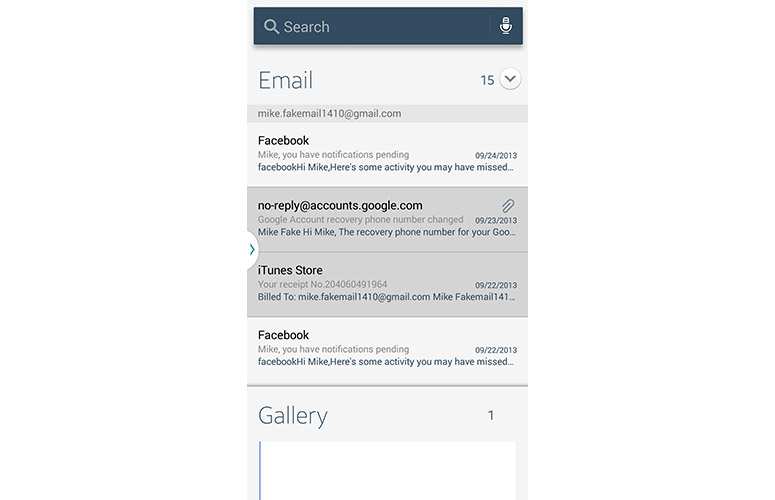
Click to EnlargeS Finder provides a powerful internal search engine that allows you to search all your recent activity by keyword, pulling up emails, scrapbook entries, videos you've watched and Web pages you've visited. When we tagged a scrapbook page with the word "house" and then entered that term as a keyword, the page appeared as a result. The engine even searches through handwriting in notes, as shown when it found the text "ABC" in one of our Action Memos, even though this handwriting had not been translated to ASCII. Better still, if you don't enter any terms, you can see a list of all your activities from today, yesterday, the past seven days or the past 30 days.
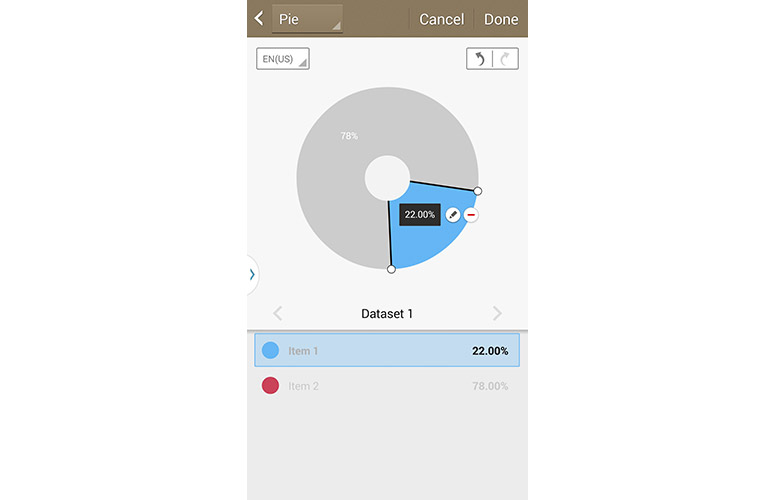
Click to EnlargeFor the Galaxy Note 3, Samsung also updated S Note, its powerful note-taking app. In addition to a new, clean, white design and the ability to sync with Evernote, S Note has a new feature called Easy Chart, which allows you to create bar, line or pie charts just by sketching. However, we found it hard to get precise numbers and wished we could import data from one of our existing spreadsheets. As in earlier versions, the new S Note allows you to create notebooks and write on a series of background templates, such as a picture diary, checklist or ruled paper. You can translate your scribbles into ASCII text, make them into vector graphics or even evaluate them as mathematical formulas.
S Note also allows you to insert video, maps, voice memos or photos into your notes. The app even provides a record feature which allows you to capture and playback all your strokes and scribbles in the order in which you drew them. However, we liked S Note best when we were simply scribbling notes in a meeting, as it felt like we were using a real paper notepad.
The phone also includes SketchBook for Galaxy, a fairly advanced drawing app that allows you to choose from dozens of different brushes, add text to your drawings, use gradients or include clip art symbols. The Pen.Up app showcases the best drawings made by Galaxy Note users.
Bundled Apps
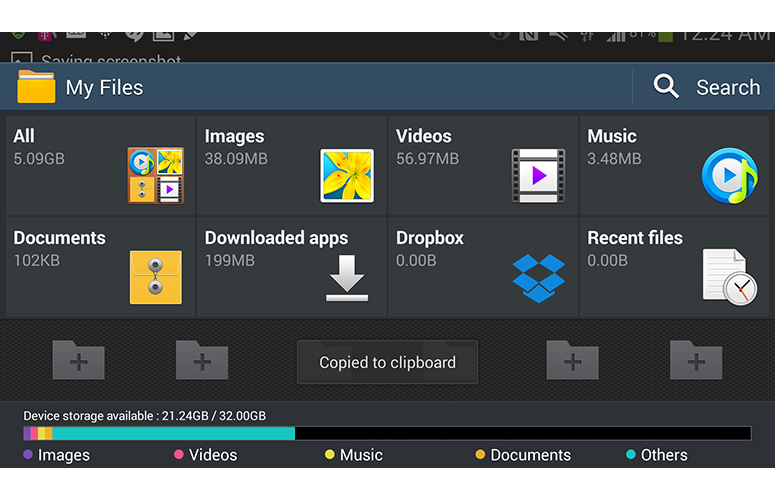
Click to EnlargeIn addition to the pen software that's made just for Galaxy Notes, Samsung includes a number of its proprietary apps found on other Galaxy phones. S Health keeps track of your fitness, recording how many steps you've taken each day and helping you toward your goals. KNOX provides a separate environment for business apps and data, a feature that many companies use as part of their BYOD (bring your own device) strategies. S Translator helps you conduct a foreign language conversation by translating another person's voice into English text and your voice into another language. However, it is awfully similar to Google Translate.
Using the Galaxy Note 3's infrared port, WatchOn, enables you to turn the phone into a smart remote control; you can change channels on your TV and find videos online to watch. Group Play empowers you to stream content to friends in the same vicinity and even lets you all play the same song at the same time. Story Album turns your photos into printable or browsable albums. Surprisingly, Samsung does not include Optical Reader on the Note 3, an app on the Galaxy S4 that takes pictures of business cards and adds them to your contacts.
T-Mobile added Lookout Security and a few of its own apps, including T-Mobile TV, Mobile Hotspot and Visual Voicemail. Fortunately, these are all grouped under the T-Mobile folder in the app drawer, so you don't have to spend time swiping past them.
Gesture and Eye Control
Like the Galaxy S4, the Note 3 supports several types of eye and gesture controls, most of which feel more like parlor tricks than helpful features. Smart Scroll moves up and down Web pages when you raise or lower your gaze, while Smart Pause stops video playback when you move your eyes away from the screen. Air Call Accept lets you answer a call by waving your hand in front of the screen, while Air Jump lets you scroll Web pages with a wave. Air Browser allows you to cycle through images in the gallery by waving your hand from side to side in front of the screen.
Air View
Like its predecessor did, the Galaxy Note 3 offers Air View previews when you hover your pen over certain content. We appreciated being able to see thumbnails of all the images in a gallery or the text of an email in the inbox by placing the stylus tip above the screen. If you change a setting under the motions and gestures section of the settings menu, you can also use Airview with a finger.
MORE: 10 Best Android Smartphones
Performance
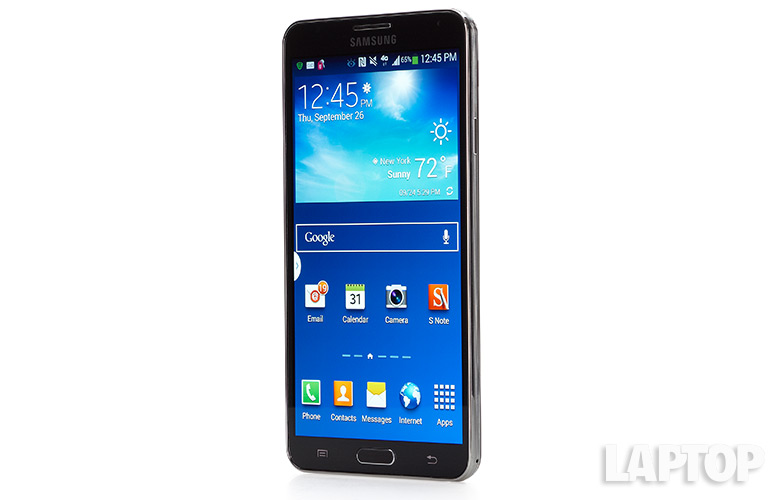
Click to EnlargeWith its 2.3-GHz, quad-core Qualcomm Snapdragon 800 CPU and 3GB of RAM, the speedy Galaxy Note 3 provided enough performance to easily run demanding Android games like "N.O.V.A. 3" and "Riptide GP 2." However, Samsung's apps can be sluggish and mar the experience, as the mail client took more than 2 seconds to open a new compose-email window, while the same action took less than a second in Gmail and on the HTC One.
The Note 3 took just 5 minutes and 15 seconds to convert a 204MB full-HD video to 480p using Vidtrim. That's a lot faster than the smartphone category average of 7:44, the LG G2's time of 6:51 and the HTC One's mark of 7:34.
On Antutu, a synthetic benchmark that measures overall performance, the Galaxy Note 3 scored a strong 33,894, which is nearly double the smartphone category average of 17,534, handily beating the Snapdragon 600-powered HTC One (23,487) and Galaxy S4 (24,196). Even the LG G2, which also has a 2.3-GHz Snapdragon 800 CPU, registered a lower 29,387.
The Note 3 scored an impressive mark of 18,808 on the 3DMark Ice Storm Unlimited graphics test. That's about 50 percent faster than the 12,071 smartphone-category average, comfortably ahead of the LG G2 (14,762) and miles above the HTC One (10,325).
MORE: How to Backup Your Android Device
Battery Life
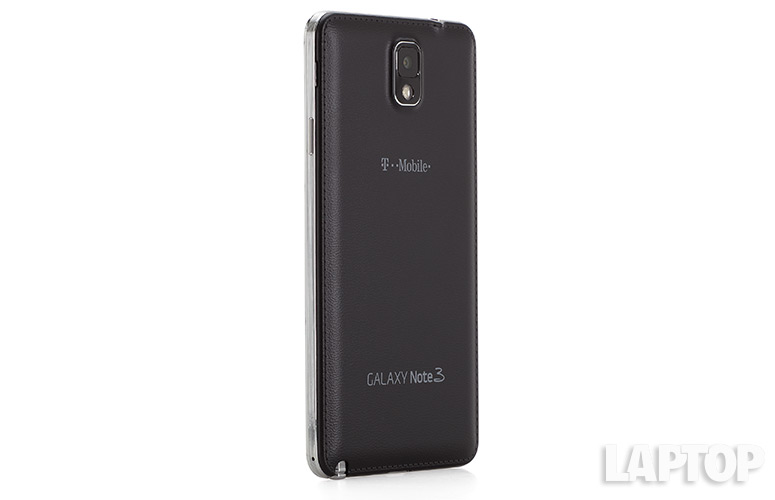
Click to EnlargeThe Galaxy Note 3's epic battery life may be reason enough to purchase this handset. The smartphone lasted an eye-popping 11 hours and 15 minutes on the LAPTOP Battery Test, which involves continuous surfing over 4G LTE. That's nearly double the 6 hour and 16 minute battery smartphone category average and hours ahead of the T-Mobile Samsung Galaxy S4 (6:41), the T-Mobile HTC One (8:17) and the AT&T iPhone 5s (5:46).
The LG G2 lasted more than 13 hours on a charge, but has a much dimmer screen. Since you can replace the battery, there's a good chance an accessory maker will market an extended battery that thickens the phone but increases the battery life by several more hours. Like other Samsung phones, the Note 3 provides NFC support, but does not provide wireless charging capability out of the box.
Camera
The Galaxy Note 3's 13-MP, rear-facing camera provides some of the sharpest, brightest and most colorful images we've seen on any smartphone, easily offering more detail than do competitors such as the iPhone 5s and HTC One. When we shot images of a tree on our office roof, the leaves and surrounding grass looked sharper and more life-like than on the iPhone's 8-MP sensor or the One's 4-MP shooter.
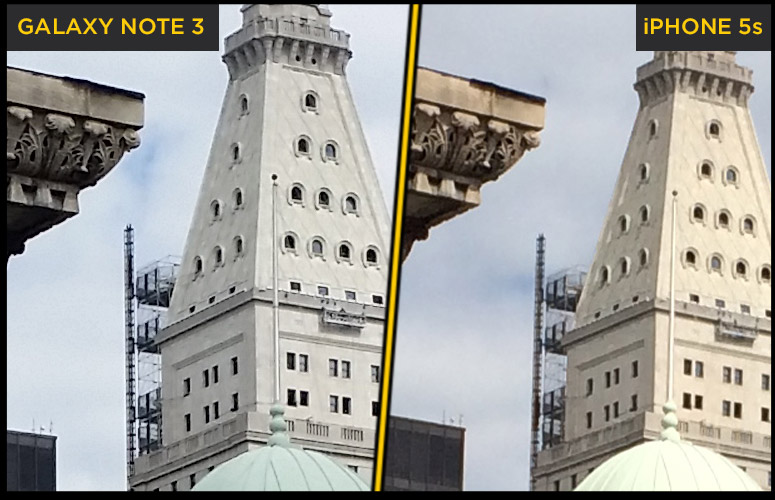
When we zoomed in on a photo of a building, the differences between the two cameras were even starker. The spire at the top of the building appeared blurry on the iPhone's shot, while the Galaxy Note 3's picture showed additional lines and textures. Colors were generally richer and more saturated on the Note 3 than on the iPhone 5s, though some users may find the iPhone's colors more accurate, depending on the scene.
[sc:video id="N2cHE1cTrq2hBQvl2CWhX00mHQM7pC4P" width="575" height="398"]
When we shot a 1080p video of cars driving down a street, images were equally sharp, and colors like the yellow on cabs and the blue on a bus really popped. The iPhone 5s provided video of similar quality, but the HTC One's clip wasn't quite as sharp.
The Note 3's 2-MP, front-facing camera also captures high-quality photos. An image of our face that we shot in a shadowy area was still bright, and showed every follicle in our beard.
MORE: Smartphone Camera Shootout 2013
Camera Features
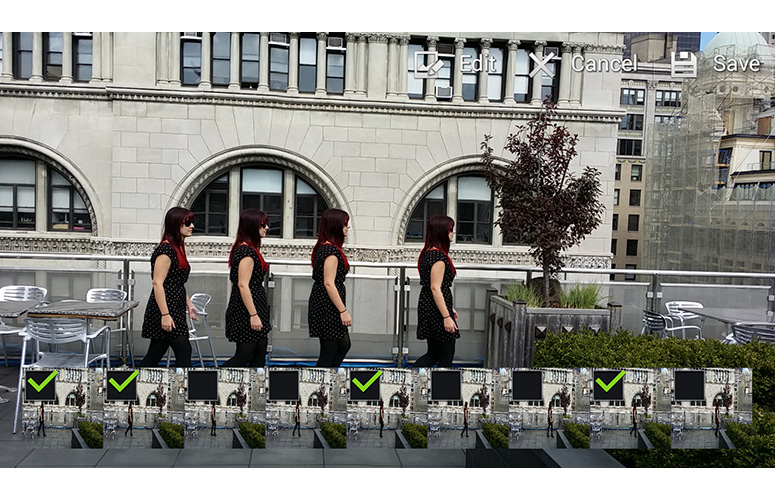
Click to EnlargeLike the Galaxy S4, the Galaxy Note 3 has a slew of custom camera features, many of which are extremely useful and fun. The Eraser feature automatically filters out strangers who walk through your frame when you are shooting in public. Drama Shot takes a series of photos and stitches them together to show a person or object moving through the scene.
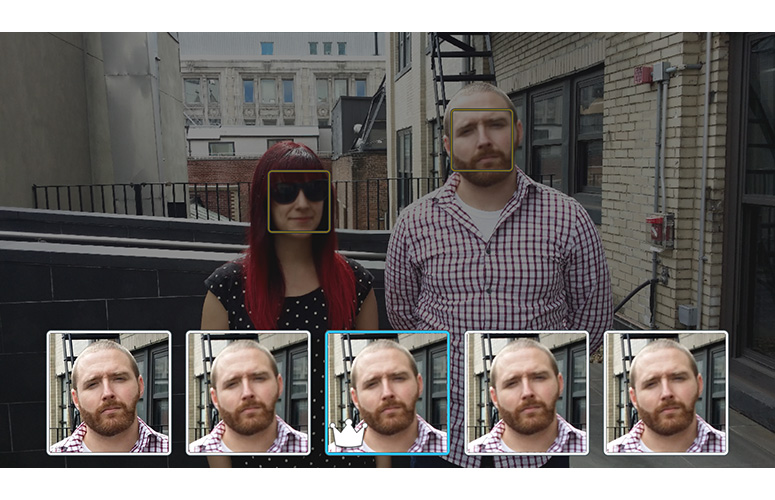
Click to EnlargeBest Face takes several shots of a group of people and allows you to choose the best head for each, while Best Shot just lets you choose the best photo from a burst. Dual Camera mode allows you to shoot stills or video with both lenses at once, placing an image of your face in a box on top of the primary photo. We particularly enjoyed Animated Photo Mode, which we used to create an animated GIF of two colleagues on our roof, with just one of their heads moving.
4G Speeds
Though the new Note is available on all the major U.S. carriers, our Galaxy Note 3 review unit rode on T-Mobile's nascent 4G LTE network, which at present serves about 154 markets. Testing in a New York apartment where we had a full four bars, the Note 3 provided a very strong average download speed of 19.4 Mbps, but a mediocre average upload speed of 1.7 Mbps.
Call Quality
The T-Mobile version of the Samsung Galaxy Note 3 offered solid voice quality on T-Mobile's network. When we spoke to a friend on the phone, our voice was accurately received, while incoming audio was consistent with other phones we've tested.
MORE: 6 Hottest Smartphones Right Now
Value
T-Mobile charges $199 up front for the Galaxy Note 3, with monthly payments of $21 a month for 24 months or a one-time price of $703.99. Both Verizon and AT&T charge $299 for the Note 3, with a two-year contract. The network offers contract-free plans that start at $50 a month for 500MB of data, rise to $60 for a more reasonable 2.5GB of data and max out at $70 a month for unlimited data.
Verdict
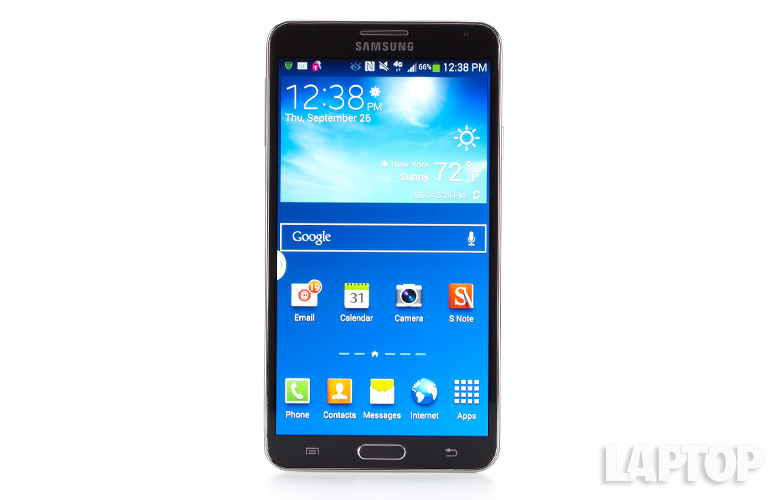
Click to EnlargeThe Galaxy Note 3's all-day battery life would be reason enough to recommend this phone. However, when you also consider its best-in-class screen, sharp camera, powerful software and pen-enabled apps, it's hard to not to want this Android phablet. Users who desire a smaller or less expensive handset may opt for the Galaxy S4 or HTC One, both of which cost $100 less on T-Mobile. Those who like Apple's operating system will still prefer an iPhone 5s. However, if you're looking for the most versatile smartphone that money can buy, you'll love the Galaxy Note 3.
Samsung Galaxy Note 3 Specs
| Alternate Carriers | Verizon, Sprint, AT&T |
| Bluetooth Type | Bluetooth 4.0 |
| Brand | Samsung |
| CPU | 2.3-GHz Qualcomm Snapdragon 800 |
| Camera Resolution | 13MP |
| Carrier | T-Mobile |
| Company Website | www.samsung.com |
| Display (main) | 5.7 inches |
| Display Resolution | 1920x1080 |
| Form Factor | Candybar Touchscreen |
| Front Camera Resolution | 2 MP |
| GPS | Yes |
| Has Stylus | Yes |
| Internal Memory | 32GB |
| Memory Expansion Type | microSD Card |
| OS Family | Android |
| Operating System | Android 4.3 |
| Phone Display Size | 5.7 |
| Processor Family | Qualcomm Snapdragon 800 |
| RAM | 2GB |
| Size | 5.95 x 3.12 x 0.33 inches |
| Weight | 5.9 ounces |
| Wi-Fi | 802.11 a/b/g/n/ac |

